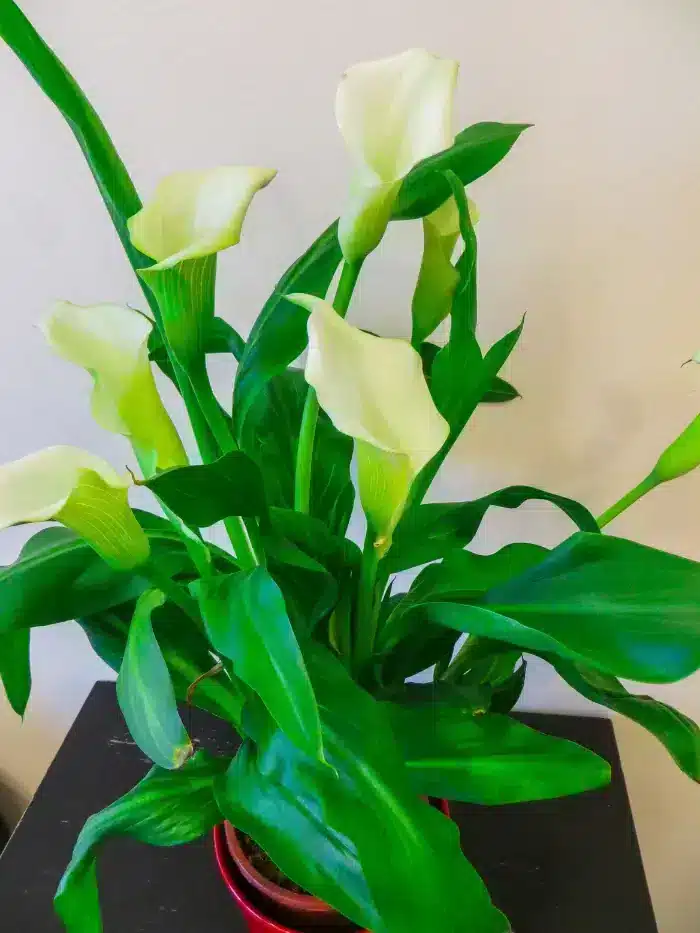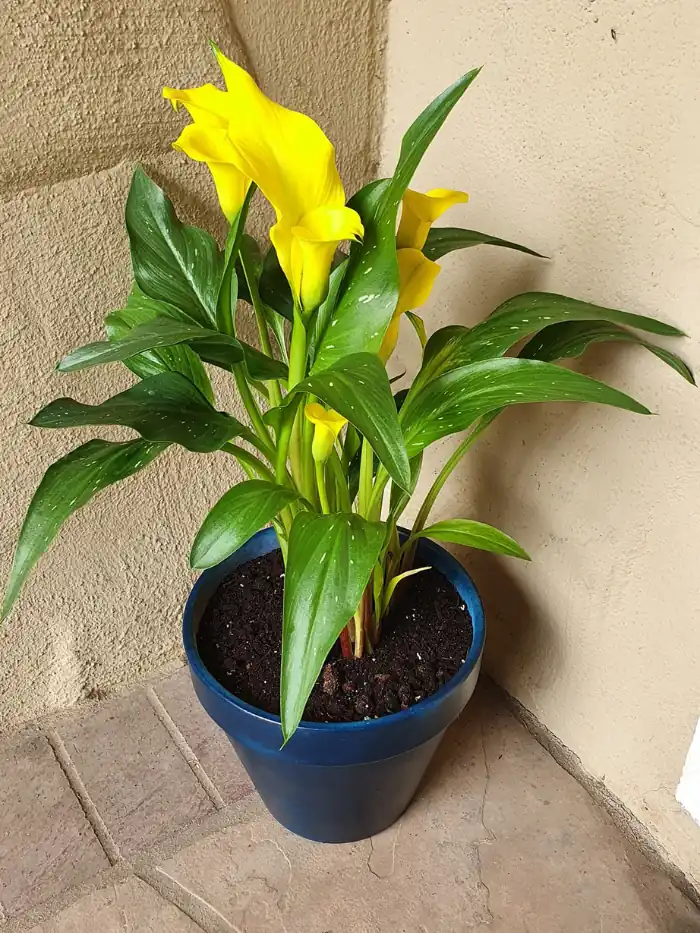How to Care for Calla Lillies After Blooming
Calla lily rhizomes go dormant after the flowering period and might not regrow, depending on how you care for them. In worse cases, the rhizomes get killed by frost if not well-taken care of.
So, how do you care for calla lilies after they bloom?
The rule of thumb to deadhead spent calla lily flowers and leaves at the end of the blooming period. Keep watering the plant until its leaves turn brown and crispy to strengthen the rhizomes and make them store more energy for the next season. Dig out outdoor calla lily rhizomes and keep them in a cool, dry space at 50-60°F.

To make calla lilies bloom again, water the plant when the top half inch of soil is dry, and put them in full sun or 25% partial shade. In addition, apply phosphorus-rich fertilizers to encourage blooming.
Jump to:
How to care for calla lilies after blooming
Calla lilies bloom for about four to six weeks before their rhizomes become dormant to prepare for the following growing season.
Calla lilies display showy, spadix flowers in various colors, emerging at different times, each blooming for a specific time. When some flowers start to bloom, others are finishing. Spent flowers usually turn green and appear like a tube but don’t drop off the plant.
Meanwhile, the leaves remain lush green for some time, turning yellow to brown and dying.
For indoor calla lilies, cutting spent flowers and leaves is necessary. Here’s how you can do it.
Deadhead spent blooms
Spent flowers turn green and curl, making the calla plant ununiform. Cutting them is necessary for two reasons; it makes the plant channel its energy to the other blooming flowers and cleans up the plant, making it appear neater and more uniform.
Cut the spent flowers from the rear end from which they emerge near the base of the soil. Keep removing them until the blooming period is over.
Prune yellowing leaves
Some calla lily leaves might recede by turning yellow while the plant is blooming. However, most remain green the entire period until when the rhizomes become dormant.
Remove yellowing leaves to allow the plant to channel its energy to strengthen the rhizomes and store more food for the next growing season. Keep in mind that calla lilies are perennial plants and will come back the next season.
Water the plant less frequently
After calla lilies finish blooming, their leaves remain lush green for some time before they fade and turn yellow. Water the plant less frequently, say once weekly, to help the rhizomes store more food, which they’ll use in the following growing season.
Calla lilies perform well in moist, well-draining soils. Irrigate the plant when the top few inches of soil are dry to maintain moisture until the plant becomes dormant.
Be careful not to overwater, as it can lead to root rot, fungal infections, and drooping in calla lilies, preventing the plant from regrowing in the next season.
Dig out the rhizomes and store them in a cool, dry place
Calla lilies are susceptible to freezing temperatures below 25oF, which damages and kills their rhizomes. That’s why in colder USDA zones below 8, calla lilies cannot be left outside. On the other hand, calla lilies can remain outdoors year-round in warmer zones of 8-11 since the temperatures don’t drop too low.
Dig calla lily rhizomes and store them to let the frosts disappear, then replant them in early spring.
If you live outside USDA zones 8 with colder winters, wait for your calla lily leaves to turn brown and die in early fall or late summer. Pluck the brown leaves or cut them to about half an inch.
Dig around the calla lily roots with a shovel and remove their rhizomes or bulbs from the ground to overwinter them, so they don’t die or get damaged from frost.
After removing the rhizomes, shake off dirt or soil, put them in a container, and keep them in a cool, dry space for about 1-2 weeks to let them dry.
Dip the rhizomes or bulbs in peat moss or sawdust to dry them, then store them in a cool, dry place of 50oF- 60oF over winter and replant them in early spring.
Do calla lilies bloom more than once?
According to North Carolina State University, calla lilies bloom from late spring to early summer. They bloom yearly, provided they are well-taken care of after the blooming period.
Calla lilies (Zantedeschia sp.) produce showy, small, spadix flowers covered in a white spathe. The flowers emerge from the ground along a long stem-like structure. The flowers usually appear at different times and stay around for about one to weeks.
Spent blooms fade and turn green but don’t fall off the plant like other flowering plants.
How to Make Calla Lilies Bloom
Healthy calla lilies bloom for about four to six weeks before becoming dormant. However, your calla lily may fail to bloom due to unfavorable environmental and soil conditions.
Here are the four primary reasons calla lilies don’t bloom and the fixes to each problem.
Feed them a phosphorus fertilizer
Although nitrogen encourages fast growth and lush and green leaves, excess prevents flowering or blooming. Calla lilies don’t bloom due to excess nitrogen because the plant concentrates its energy and nutrients on growing dark green leaves rather than producing flowers.
Apply phosphorus-rich fertilizers to encourage blooming where there’s excess nitrogen.
Place them in full sun or partial shade
Calla lilies perform well under the full sun for at least six hours or 25% partial shade. Under low light, calla lilies don’t thrive, preventing them from blooming.
To make lilies bloom, place indoor calla lily pots with direct sunlight. South-facing windows are your best bet. There should be no obstructions such as trees or buildings where calla lilies grow to expose them to the full sun so they bloom.
Keep them well-watered
Calla lilies prefer well-draining, organic-rich, moist soils. Frequent watering is necessary to make the soil moist. However, the soil should not be soaked, as the plant can develop root rot and fungal infections.
To make lilies bloom, water the soil regularly and don’t let it dry. Check the top half inch of soil by dipping your finger into it and observing stuck soil particles. Apply water when the top half inch of soil is dry.
When should you deadhead calla lilies?
Deadhead calla lilies flowers immediately discolor and cut their leaves when they turn brown and crispy. Deadheading calla lilies don’t encourage prolonged blooming or increased blooms, unlike other flowering plants. In addition, calla lily flowers don’t drop off the plant after flowering.
Calla lilies bloom for about four to six weeks, and their rhizomes become dormant. Their flowers appear at different times; some might have finished blooming when others are emerging. Each flower stays for about one to two weeks, then discolors.
Cut the faded flowers immediately to clean up the plant and make it look neater.
After blooming, calla lily leaves remain green and lush for some time before the rhizomes become dormant. Don’t deadhead or prune them. Let them turn yellow or brown, become crispy, and die.
When the leaves turn brown and die, you know the rhizomes have become dormant, thus the perfect time to deadhead them.
Cut or pluck the brown, crispy leaves off the plant, dig the dormant rhizomes or bulbs, and store them indoors until the threat of frost has passed.
What do you do with calla lilies after they bloom?
After calla lilies bloom, dig out their dormant rhizomes and overwinter them indoors to replant them in early spring.
Calla lilies enter the dormancy stage after blooming, where their rhizomes or bulbs become dormant over winter and regrow in early spring. If you live in colder zones below 8 with freezing temperatures below 25oF, digging the rhizomes is necessary to prevent frost from damaging and killing.
Just after blooming, calla lily leaves turn yellow, brown, crispy, and die. However, they don’t drop off the plant. Cut them with a knife or scissors, then dig up the dormant rhizomes, careful not to damage them. Shake off the soil from the rhizomes and store them in a cool, dry place at 50oF- 60oF so they can dry.
Dip the rhizomes in sawdust or peat moss, and store them in a cool, dry place until early spring for replanting.
Video
Conclusion
Calla lilies bloom in late spring to early summer. These tender perennials boast of showy, small, spadix flowers and lush green, white-spotted leaves.
After the flowers bloom, it’s necessary to care for the plant, lest they don’t bloom in the following growing season. If you have a potted calla lily indoors, remove the spent flowers and yellowing leaves when the plant is blooming. You can leave outdoor ones, although cutting them doesn’t hurt.
Overwinter dormant calla lily rhizomes or bulbs to protect them from frost damage or death, especially if you live in colder climatic zones outside USDA 8-11.
When keeping the dormant rhizomes, smear them with sawdust or peat moss, cover them in a plastic bag, and store them in a room at 50oF-60oF.


![Are Calla Lilies Annuals or Perennials? [EXPLAINED]](https://gardenine.com/wp-content/uploads/2020/08/Are-calla-lilies-annuals-or-perennials.webp)
